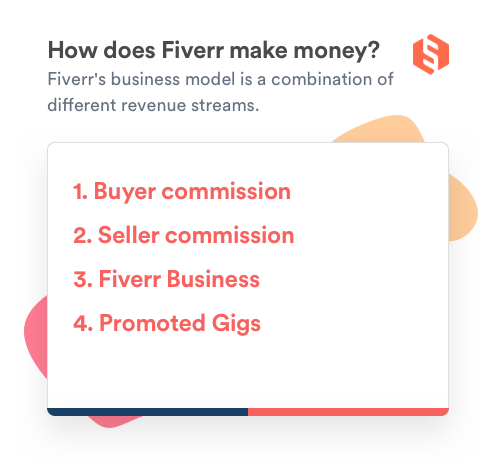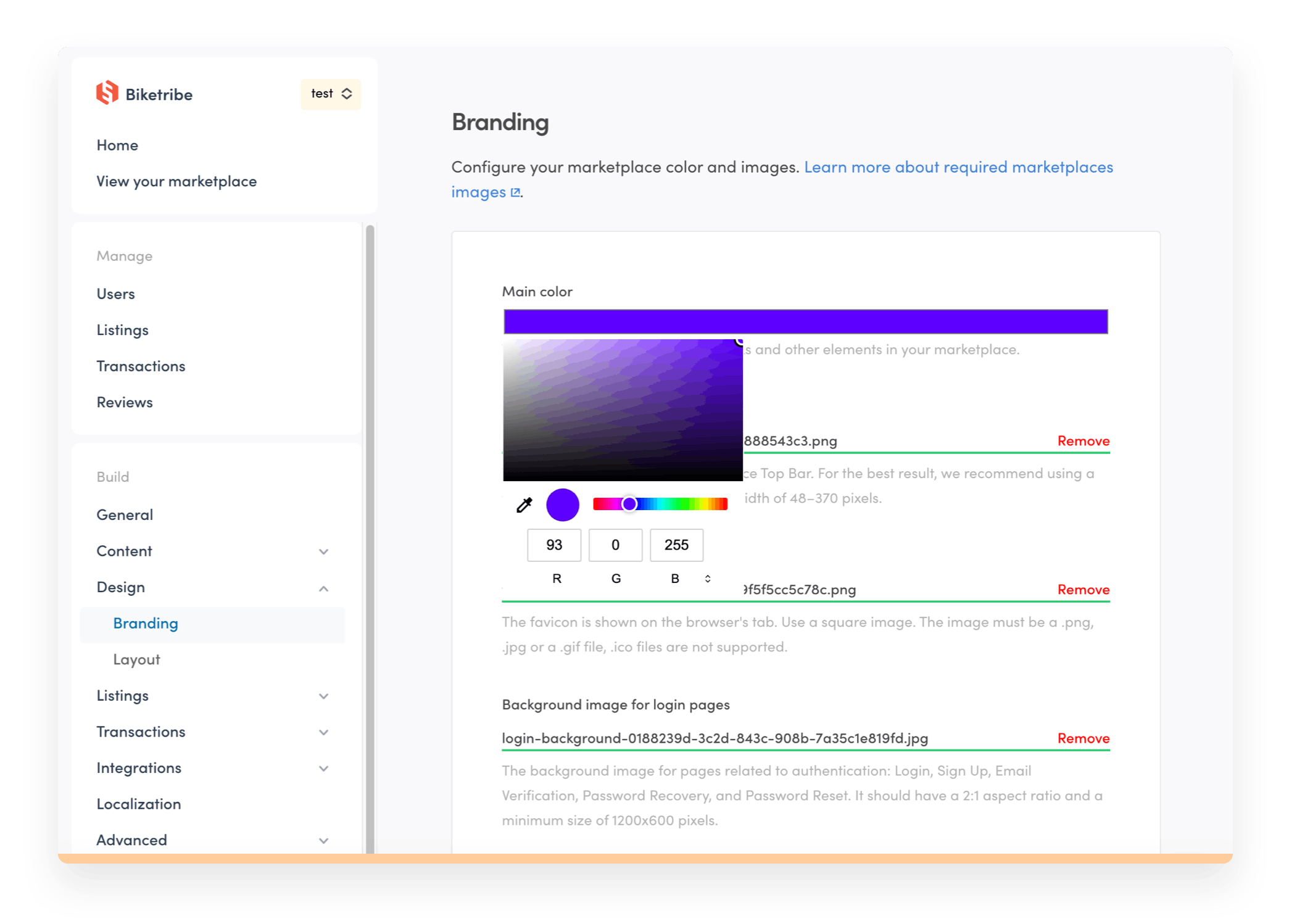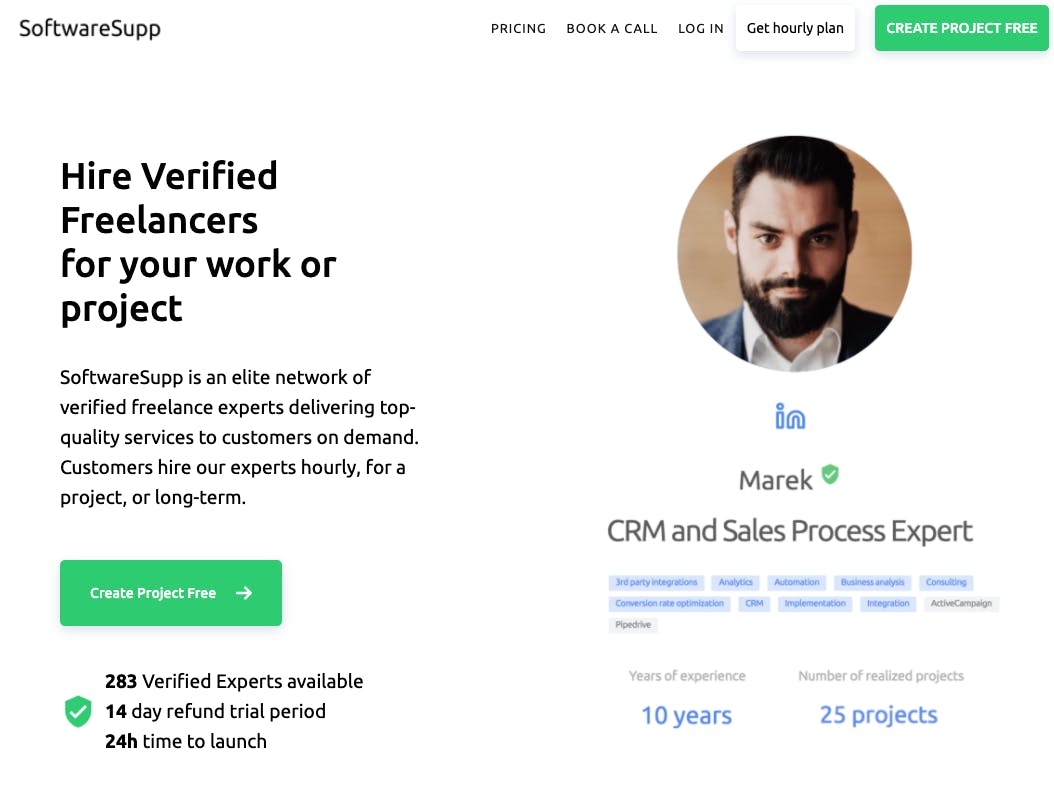How to build a website like Fiverr
Fiverr connects millions of businesses around the world with top freelance talent in over 500 different skills. This guide explores how you can design, build, and scale your own marketplace like Fiverr.
Table of Contents
Fiverr is one of the best-known freelance marketplace platforms. It connects companies around the world with top freelance talent. The platform is one of the pioneers of the future of work. In 2020, Fiverr connected more than 3.4 million buyers with freelancers in more than 160 countries.
As of the summer of 2021, Fiverr is a public company valued at $7.5 billion. The platform has grown fast since it was founded by Micha Kauffman and Shai Wininger in Israel in 2010. Today, Fiverr offers digital services in more than 500 skills across eight categories.
There’s never been a better time to launch a marketplace platform like Fiverr.
Micro-job platforms like Fiverr have become more and more popular as the shift toward remote work has accelerated. Businesses of all shapes and sizes are looking for flexible solutions that let them connect with high-quality talent on a freelance basis. In the past year alone, Fiverr’s revenue nearly doubled.
There’s never been a better time to launch a marketplace platform like Fiverr. In this guide, we’ll explore how you can build your own Fiverr-style marketplace business.
Let’s dive in.
Fiverr is a two-sided marketplace platform that enables people to buy and sell professional services online. The platform started out offering services like translation and logo design for $5, and now offers hundreds of services at different prices.
Freelancers create a profile on the site and set up their own “gigs”. Each �“gig” is a project offered by a freelancer – for example, creating a short animated video. These “gigs” summarize the freelancers’ skills and experience and outline the projects available at various price points.
Clients search for “gigs” and freelancers that meet their needs and then pay in advance. Funds are held in escrow until the successful completion of the project.
Freelancers get access to a large pool of customers, the flexibility to work on their own schedule, and the opportunity to earn money on the Fiverr platform. For buyers, Fiverr is a quick, affordable way to outsource work to a diverse talent pool without compromising on quality.
Marketplace businesses like Fiverr make money primarily through commission.
Fiverr charges buyers a 5.5% fee, with an additional fee of $2 for orders under $50. When an order is completed, Fiverr takes an additional 20% commission from the freelancer’s payout. That means that on every sale through the Fiverr platform, the company makes over 25% in commission.
Most marketplaces like Fiverr make money through commissions.
The commission model is a popular revenue model for sites like Fiverr. It’s used by Fiverr competitors Upwork and Toptal, and it’s also favored by other popular marketplace businesses, including Etsy and Airbnb.
As Fiverr has grown, the company has added new revenue streams.
One is Fiverr Business, a $149/yr platform that makes it easier for large enterprises to collaborate with pre-screened freelancers on larger projects. Another is Promoted Gigs, a cost-per-click advertising product that lets freelancers appear higher in search results by boosting their “gigs”.
While commission-based models tend to work best for marketplaces like Fiverr, you should consider a range of options when choosing the right marketplace business model for your marketplace. It's no exaggeration to say your business model can make or break your marketplace. But even once you’ve settled on a business model, there are more decisions to be made.
Say you opted for a commission-based revenue model, like Fiverr. Now, you need to determine how much to charge and who to charge – the buyer or the seller. Fiverr can charge sellers a 20% commission because it connects them to millions of buyers. At first, it’s unlikely a new marketplace will be able to justify that high a commission.

For new marketplaces, the fee structure must be low enough to attract new sellers but high enough for the business to make money. Marketplace websites cost money to run, and you need to create a sustainable revenue model which scales with your business.
As you grow, take a leaf out of Fiverr’s book and consider adding new revenue models like premium memberships or advertising products.
Related: How to choose the right business model for your marketplace
Fiverr has carved out a significant niche. It has been successful in building clear points of differentiation versus their key competitors. Since the beginning, the platform has thrived because its large community of sellers can provide low-cost work.
There are a range of other successful freelancer marketplace companies who offer similar but differentiated services to Fiverr. As you consider your own Fiverr-like marketplace idea, keep in mind the points of differentiation that Fiverr’s competitors have created:
High-quality clients: Upwork
Upwork is Fiverr’s largest competitor. They focus primarily on long-term engagements and large projects rather than the one-time “gigs” Fiverr specializes in.
Upwork has a reverse marketplace flow: buyers post jobs, and sellers apply for them. This gives buyers more control over the scope of their projects and the ability to build long-term relationships with freelancers. Freelancers can seek out interesting projects and build a stable of long-term clients with reliable work.

High-quality freelancers: Toptal
In many ways, Toptal is the opposite of Fiverr. Where Fiverr connects businesses with a wide range of freelancers at a low cost, Toptal connects businesses with a smaller number of high-quality freelancers at a high cost. Clients partner with Toptal experts to connect with well-matched freelancers.
Toptal rigorously screens freelancers before allowing them on the platform and claims to only include the top 3% of freelance talent on their platform. Toptal freelancers often boast backgrounds at top companies and sought-after skills like software development and product management.

Low cost: Truelancer
Fiverr initially started with only $5 gigs, but as the platform has grown, services have become more expensive. Platforms like Truelancer have stepped in to fill the gap, connecting companies with freelancers from low-cost-of-living countries.

Specialization: Contentfly, Paperound, SoftwareSupp
The easiest route to creating differentiation is often to focus on one particular niche. For example, Contentfly focuses on content writing, Paperound only lets buyers hire students at U.K. universities, and SoftwareSupp focuses exclusively on software development work.
Paperound and SoftwareSupp are powered by Sharetribe software. Specialized micro-jobs marketplaces like these make it easier for buyers to find the right talent for their projects. For founders, it’s easy to tailor the features of the platform to closely match the needs of users.

To compete effectively with a well-established marketplace platform like Fiverr, there are a few things to bear in mind. Focus on solving a very specific problem better than Fiverr does. Make sure your problem applies to a large enough group of people. And figure out a scalable business model that attracts sellers and buyers to your marketplace.
Our advice? Start by focusing on a small niche or geography, and once you’ve gained initial traction, start expanding into new areas.
To learn more, check out our interview with Connor Gillivan, founder of FreeeUp, a freelance marketplace for the eCommerce industry. Connor discusses his journey with FreeeUp and shares how his startup is successfully taking on marketplace giants like Fiverr and Upwork.
Building a website like Fiverr is complicated. Competition is fierce, and it’s impossible to carve out a niche for your marketplace without creating a smooth user experience that gives users all of the essential features that they need.
It’s likely that many buyers on your Fiverr-like marketplace will be established businesses. This adds a layer of complexity – a lot of businesses have specific requirements when it comes to entering contracts, sharing privileged information, and processing payments. Building trust between buyers and sellers on your platform is critical as well.
Specializing in a small niche helps you tackle these challenges and serve your audience better. But under the hood, the core features of most Fiverr-like websites are always the same.
This is good news for aspiring marketplace entrepreneurs!
When Fiverr first started, even the most basic features had to be built from scratch. Such a task would take months of development. Nowadays, there are many kinds of shortcuts that can cut that time radically. Before comparing a few alternative solutions, we'll briefly discuss the essential building blocks of websites like Fiverr.
There are essentially two main types of micro-jobs marketplaces:
- Regular marketplaces like Fiverr, where sellers post jobs and clients contact them.
- Reverse marketplaces like Upwork, where clients post job descriptions and sellers apply to them.
The type you choose has a big impact on the feature requirements for your job platform. Let's look more closely at the core features that build a marketplace user experience like Fiverr's.
 Buyer and seller profiles
Buyer and seller profiles
Both buyers and freelancers should have their own profiles to establish mutual trust. All profile pages should include basic information including a name, picture, and location. Freelancer profiles should also include a list of skills, a description of services, and reviews from previous clients.
 Listing pages
Listing pages
Listing pages are a digital storefront that let freelancers communicate their skills and projects. Freelancers should be able to include text, images, videos, and testimonials from previous clients on these pages.
 Website navigation and search
Website navigation and search
Potential buyers must be able to easily navigate the site and find freelancers that offer the services they’re looking for. There are two main ways to do this: website navigation and search. Your marketplace site should have both.
For simple website navigation, organize the services offered under categories, like ‘marketing’ or ‘web development’. Consider adding subcategories for broad categories.
A search function enables users to quickly locate freelancers who are perfectly qualified to work on their project. Needless to say, building your own search engine is highly complex, so consider using a Fiverr-like website builder that offers a pre-built search function.
Under the hood, the core features of most Fiverr-like websites are always the same.
 Online payments
Online payments
Buyers and freelancers must be able to complete transactions securely on your marketplace. This is much more complex than it seems. In fact, the payment flow on marketplace websites is among the most complicated of any online business. (You can find out more and compare the different providers in our complete guide to marketplace payments.)
Marketplace sites like Fiverr typically charge buyers for the project up front, take a commission, and then hold funds in escrow until project completion, when payment is released to the freelancer.
However, all payments must be processed without going through the bank account of the marketplace owner. Otherwise, regulators may judge that your marketplace is acting as a bank with sellers’ money – opening you up to complicated banking regulations.
Because of the complexity in handling online payments, it makes sense to work with online marketplace payment providers that have tools to manage online payments. By using software like this, it’s also straightforward to handle integrations with third-party payment providers.
 Reviews
Reviews
Reviews build trust between users on your platform. The more reviews a freelancer has, the more successful they tend to be, as buyers trust their ability to get the job done. Reviews typically include a rating and feedback from previous buyers.
 Communication tools
Communication tools
Many of the projects completed on these sites are very cooperative in nature. It’s important that buyers and sellers can use your platform to send messages, share files, and even host virtual meetings.
In building your communication tools, consider ways to address platform leakage, which occurs when buyers and sellers take transactions off your marketplace platform.
 Admin features
Admin features
Both buyers and sellers need access to tools that help them manage their presence on the platform.
Buyers will need access to contracts, the ability to manage billing methods, and a portal to view the invoices they receive from freelancers.
On the seller's side, freelancers need reports to track their earnings, the ability to manage pricing, and tools to learn how to improve the performance of their listings.
These are some of the features almost every website like Fiverr will always need, regardless of the niche they focus on. This is good news for aspiring marketplace founders! That means it's possible to take advantage of marketplace software like Sharetribe's and save months working on basic features.
When it comes to building out your Fiverr-style website, there are a range of options to consider.
The path you take will be driven by the features that your unique marketplace needs, the technical skills your team has, and the level of budget and time you’re willing to spend on building your platform.
There are many ways to develop a marketplace. Here are the four most relevant to building a micro-jobs marketplace like Fiverr.
If you’re experienced in frontend and backend development, custom building a marketplace platform from scratch is possible. But even for experienced developers, this is a complicated project, and will likely take several months.
Our Full Stack Developer, Mikko, has written a guide to the process of developing a marketplace app from scratch.
Developing a site like Fiverr from scratch is a time-consuming task even for an experienced developer.
Benefits of coding a Fiverr-style marketplace from scratch
The most obvious benefit of building from scratch is that you can create the exact feature set and design that you want for your marketplace. Done right, it’s possible to build a scalable core architecture that is not dependent on any third-party software or systems.
Drawbacks of developing a Fiverr-style marketplace from scratch
While custom development seems attractive at first, the drawbacks significantly outweigh the benefits. Building from scratch can take months, and maintaining every aspect of your own infrastructure is costly and exhausting. You’ll spend the majority of the development process coding the basic elements of the platform, not innovating exciting new features.
If you’re not a developer, outsourcing this process can cost upwards of $50,000, and development timelines will be even longer. Even when your marketplace is ready, it’s difficult to make changes or add new features without support from your external developers, pushing costs higher still.
As marketplaces become increasingly popular, new possibilities are emerging that offer entrepreneurs new ways to build marketplace platforms. One approach is to use clone scripts, which give developers the basic building blocks of a marketplace. With these scripts as the foundation, code can be tweaked to suit the needs of each unique marketplace, and developers can spend more time building exciting new features.
Benefits of using a Fiverr clone script
Clone scripts can save time and money by enabling developers to use someone else's code as the key building blocks of the marketplace.
If you take this approach, look for high-quality open-source code. Try to use scripts that include lots of pre-built features – that way, you won’t have to build lots of your own features on top.
Drawbacks of marketplace scripts
Clone scripts promise shortcuts, but in reality, there are many risks in using them to build your business.
All too often, there are major gaps in these scripts. If the code isn’t built to be customized, it’s difficult for developers to work with it – there may be redundant code, interdependencies, or a lack of documentation and technical support. Critical features like online payments are often not developed to the standard of local and global regulations.
There’s also the question of scale. When you first start working with the script, it’s difficult to know how well the infrastructure will scale. What works for 1,000 users might not work for 10,000 and almost certainly won’t work for 1,000,000 users. Plus, managing maintenance, backups, and security can become a full-time job if your marketplace reaches a meaningful scale.
It’s easy to end up with a ‘“worst-of-both-worlds” situation, where your marketplace lacks customization and is impossible to launch and scale.
If you’ve built websites on WordPress before, it could be possible to use a WordPress theme to build your marketplace. This helps get your platform up and running fairly quickly but isn’t without issues, leaving your marketplace reliant on a complex combination of WordPress plugins and themes.
Marketplace themes are affordable, but require maintenance especially at scale.
Benefits of building a micro-jobs website with WordPress
WordPress is relatively affordable, and there are multiple payment options.
Users also benefit from access to the complete WordPress codebase, as well as a huge range of different plugins and themes to add features and design elements to their platform.
Drawbacks of using WordPress to build a marketplace
While easier than custom development, using WordPress still requires fairly sophisticated development skills. Building a unique marketplace requires a network of plugins and themes. All of them need to be manually installed and maintained on your platform. If one plugin fails or needs an update, your entire marketplace could go offline. This challenge can become even more pronounced as your business scales.
Online payments are also an issue with this approach. It’s difficult to process marketplace payments and stay compliant with regulations when using WordPress. The lack of customization in payments also extends to other areas, and it’s challenging to build new marketplace features.
The best way to build a website like Fiverr is to use a dedicated marketplace platform like Sharetribe. These offer entrepreneurs the ability to launch quickly with minimal investment and the flexibility to add more advanced features as the marketplace grows.
Benefits of marketplace website builders
Marketplace software comes with all of the features you need to get started, making it easy to get your marketplace up and running quickly. All you have to do is create an account, add your copy, color scheme, and logo, and you’re ready to launch.

There’s little in the way of upfront investment (you can configure your marketplace settings completely fee with Sharetribe and only need to subscribe once you're ready to invite in users), and founders need little to no technical skills to get started. Maintenance is taken care of, and new features are constantly added that improve the marketplace experience for your users.
Drawbacks of marketplace website builders
While it’s easy to get started with a marketplace software platform, it can be difficult to fully customize features. Usually, you don’t get access to the source code that powers your marketplace, and the feature set offered can be a little more limited than on platforms like WordPress.
Fortunately, Sharetribe allows founders to customize and self-host their front-end application when they’re ready to add more advanced features to their marketplace. This requires some development but ensures you can add important features to your marketplace without worrying about issues like online payments or maintaining your system architecture.
- Create your free Sharetribe account and enter your details.
- Add your marketplace's name.
- Build your marketplace's landing page: add a slogan and description that explains what your marketplace does, upload visual assets, and more. Unsplash has great free images, but if you have some budget, check out Stocksy for creative, hand-selected visuals.
- Determine the design of your marketplace: upload a logo and other visual assets photo, and choose the layout of your search page and listing pages.
- Configure your listing settings, listing fields, and search settings.
- Choose your commission and minimum transaction size.
- Test that everything looks like and works to your liking in your Test environment.
- Once everything is ready, it's time to subscribe!
- Activate online payments by connecting a Stripe or PayPal account. You’ll be able to receive payments and collect commissions straight away.
- Check everything over one last time.
- Congratulations – your Fiverr site is ready to go. 🚀
For more information on setting up Sharetribe, check out our Help Center or chat with our Support Team - they’re available seven days a week.
Once you’re up and running, focus on growing your marketplace. Sharetribe lets you launch a powerful marketplace platform quickly and affordaably, giving entrepreneurs more time to focus on building out their user base.
Spend time with the users of your marketplace, and collect their feedback. Ask them how things could be improved, and learn about what’s important to them.
An API-based marketplace solution helps you grow your business as you learn more about your audience.
As you continue to grow your marketplace, the chances are that you’ll want to extend and customize your platform to provide a better experience for your users. Building a marketplace is a continuous process - Fiverr has been around for more than ten years and is still adding new features!
When you’re ready to embark on the next stage of your entrepreneurial journey, you can do so with Sharetribe without changing platforms or migrating data. Sharetribe is a powerful marketplace solution that allows you to launch completely no-code but also offers the flexibility to design and develop custom features. Essentially, it gives you the best of both worlds: all the essential building blocks out-of-the-box as well as infinite customizability through Sharetribe's Marketplace and Integration APIs.
Custom-developing functionality on top of Sharetribe does take some technical skills, but if that’s not you, fear not! We can connect you with a Sharetribe Expert Partner. We also have a great guide full of useful tips on hiring a marketplace developer. Building a custom platform on Sharetribe gives you the freedom to build out powerful new features and grow your marketplace without limits.

Probuddy
ProBuddy connects customers to both sports and educational services around the world.

SoftwareSupp
SoftwareSupp enables companies across the world to hire high-quality, pre-vetted software developers in less than 24 hours.
Building a successful micro jobs platform like Fiverr doesn’t have to be difficult. In fact, you can get your marketplace up and running today, without writing a single line of code.
At Sharetribe, we’ve been helping founders to build and grow exciting marketplaces for more than a decade now. We’ve learned a lot along the way. Check out the Marketplace Academy to learn more about how you can build a successful marketplace business.
But in the end, there’s only so much you can learn by reading. The best way to learn is to dive in. Start building your marketplace, launch as fast as possible, and spend time with your users to learn how you can build a platform that empowers them.
If you’ve ever thought about building a micro jobs marketplace, there’s never been a better time in history than right now. Demand is booming across a wide variety of categories, and innovative marketplace builder technology means that anyone can start building the next Fiverr, today.
Take the first step today and start building for free with Sharetribe.
Start your 14-day free trial
Create a marketplace today!
- Launch quickly, without coding
- Extend infinitely
- Scale to any size
No credit card required
